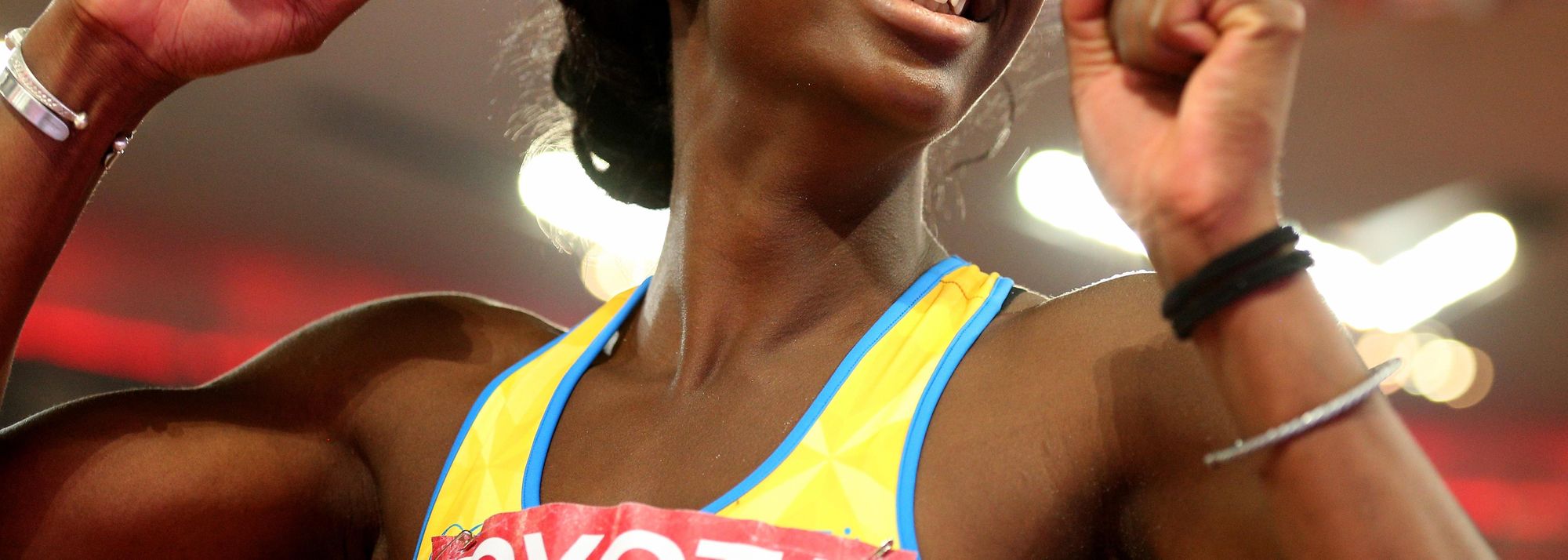Khaddi Sagnia at the IAAF World Championships (© Getty Images)
Rising long jump talent Khaddi Sagnia equalled the Swedish indoor record earlier this year. She reflects on the joy of competing at the Youth Olympic Games and a long-term injury which derailed her development for two years.
High
I have so many happy memories of competing at the 2010 Youth Olympic Games in Singapore – so much so that one day I would love to return to Singapore to relive such memories.
In 2010 I made a big progression under my coach at that time. I always knew I had a talent for jumping and I was never afraid to show what I was capable of achieving. I always wanted to do my very best in training and I loved to compete.
Earlier that season, I competed at the European Youth Olympic Trials in Moscow where I won triple jump gold. This served as a big confidence boost, although I recall standing on the medal podium a little embarrassed, because I did not know all the words to the Swedish national anthem.
I vowed to myself that later that year I would win gold at the Youth Olympic Games in Singapore and that I would sing all the words to the anthem. I recall downloading the anthem on my MP3 player and listening to it every day for a month to learn every word.
I twisted my ankle one week before the competition in Singapore. I was so upset. My coach at the time insisted I just needed to tape the ankle, but every time I trained I could still feel huge pain. It was not easy.
Thankfully, despite competing with a sore ankle, I managed to jump very well in the final. I set a PB (and Swedish U20 record) of 13.56m to win gold; I was so happy. The competition may have taken place in middle of the night in Sweden but I still remember being inundated with calls from home congratulating me. On the medal podium, I managed to sing the Swedish national anthem word for word. I was so proud of myself.
I enjoyed so many great experiences in Singapore. I met so many people from so many different countries and sports. Many competitors wanted to swap caps and clothing with athletes from other countries. I recall exchanging kit with the American athletes because the USA always has the coolest clothes.
Looking back, the Youth Olympic Games was the first time in my life when I realised I could go far in the sport. The whole experience and competition acted as a huge motivation.
Low
During the indoor season in 2012 I was training well and looking forward to competing at the XL-Galan meet in Stockholm.
I had just recorded my best ever triple jump results in training when I noticed some teammates were box-jumping. I’m the sort of person who can’t sit still when I see someone doing something fun, so I asked my coach if I could do it and she said ‘fine’.
Yet when I started to jump on the box, I fell to one side. I was not in pain but I felt something was wrong. It was only the next day, following an MRI scan, that I was told by doctors I had torn my ACL in my knee and that I would never be able to jump again.
I was shocked. I never thought I would suffer such an injury at such an early stage of my career (Sagnia was aged just 17 at the time). But I also told the doctor, ‘I believe I will jump again, you will see’.
Being raised by a single mother as the youngest of eight children was tough and some days we didn’t have food to eat. But it was going through such experiences that formed the person I am today. I am thankful for everything I have and I was determined to return to compete.
I underwent rehab exercises for 10 months. I went to the swimming pool every day for three months. I just wanted to show the world nothing could stop me.
My family and my coach, Katrin Klaup, were a huge support and after two years out of the sport, in February 2014, I made my competitive return as a sprinter during the indoor season. I performed well at the Swedish Indoor Championships and then entered my first jumps competition for 27 months, competing in the long jump close to my hometown in Savedalen.
Because of all the hard work I had put in, it was important for me to see a positive result that day, so it was an amazing feeling to jump a PB of 6.52m. It was great to be back.
Steve Landells for the IAAF








